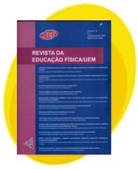<b>Variáveis espaço-temporais do andar em velocidade lenta, livre e rápida em crianças de 3 a 8 anos</b> - doi: 10.4025/reveducfis.v21i4.8309
Palavras-chave:
Andar, Velocidade, Criança
Resumo
O objetivo deste estudo foi descrever e verificar diferenças nas variáveis espaçotemporais no andar em velocidade lenta, livre e rápida, entre crianças das faixas etárias de 3 a 4, 5 a 6 e 7 a 8 anos. A amostra foi composta de 33 crianças saudáveis. Os dados foram normalizados pelo método não dimensional (Hof, 1996). Não foram encontradas diferenças significativas entre as faixas etárias no andar lento, livre ou rápido, quando consideradas as velocidades normalizadas. Houve diferença na cadência absoluta entre os grupos de 3 a 4 e 7 a 8 anos no andar livre. O comprimento do passo relativo não apresentou diferença significativa entre os grupos, demonstrando que crianças nessas faixas etárias preferem um aumento na cadência para aumentar a velocidade. Os valores temporais relativos mostram diferenças entre os grupos etários, sendo utilizada a mesma estratégia para o aumento da velocidade: diminuição do tempo de apoio duplo, aumento do tempo de apoio simples e aumento do tempo de balanço.Downloads
Não há dados estatísticos.
Metrics
Carregando Métricas ...
Publicado
2010-12-05
Como Citar
1.
Mariano CRE, David AC de. <b>Variáveis espaço-temporais do andar em velocidade lenta, livre e rápida em crianças de 3 a 8 anos</b> - doi: 10.4025/reveducfis.v21i4.8309. JPhysEduc (Maringá) [Internet]. 5º de dezembro de 2010 [citado 10º de janeiro de 2026];21(4):625-32. Disponível em: https://periodicos.uem.br/ojs/index.php/RevEducFis/article/view/8309
Edição
Seção
Artigos Originais
•Os autores detém os direitos autorais, permitindo citações de seu conteúdo em outros veículos de informações científicas e técnicas.

Este obra está licenciado com uma Licença Creative Commons Atribuição 4.0 Internacional.









_1502.jpg)











